This article is in the Category
A Story from the Archives
A Story from the Archives: Refugees 1960, a report in words and drawings by Kaye Webb and Ronald Searle
Sarah Lawrance delves into the Seven Stories archives to reveal a little-known collaboration between Kaye Webb and Ronald Searle.
Press and media reportage of refugees fleeing Ukraine over the last few months, including the remarkable drawings of illustrator George Butler, has put me in mind of an unusual collaboration between Kaye Webb – in her pre-Puffin, journalist days – and her then husband Ronald Searle.
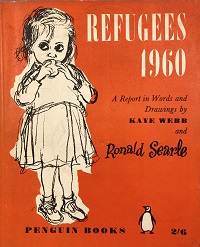 In autumn 1959 the couple were invited by the United Nations High Commission for Refugees (UNHCR) to make a tour of refugee camps in Europe, in the hope that ‘first-hand reporting might stir pity, open pocket-books and even relax restrictions more effectively than speeches or statistics.’ The Kaye Webb archive at Seven Stories contains briefings, background information, drafts and correspondence, providing insights into the whole project and its reception.
In autumn 1959 the couple were invited by the United Nations High Commission for Refugees (UNHCR) to make a tour of refugee camps in Europe, in the hope that ‘first-hand reporting might stir pity, open pocket-books and even relax restrictions more effectively than speeches or statistics.’ The Kaye Webb archive at Seven Stories contains briefings, background information, drafts and correspondence, providing insights into the whole project and its reception.
The initiative was part of World Refugee Year, a concerted attempt to focus international attention on the plight of the 110,000 or so refugees in Europe (40 million worldwide); many had been displaced since the end of the Second World War in 1945, others having fled Hungary in 1956. The majority of these were considered to be ‘hard cases’ – people who for health or other reasons had been denied entry by countries such as the United Kingdom.
The Searles’ main contact in the PR department at UNHCR was the literary-minded Roland Huntford (later a journalist and biographer); in a letter dated 19 October 1959 he set out a tentative itinerary, beginning in Vienna and ending near Athens, with a smattering of picturesque detail clearly designed to pique Ronald’s interest. Huntford planned to meet them on arrival in Vienna for a full briefing, with the enticing offer of tickets for the opera – he hoped for The Magic Flute ‘a perfectly delightful production this year’ (there is no mention of the opera elsewhere in the archive, and I suspect this either didn’t appeal, or was squeezed out of the schedule).
The couple travelled to camps in Austria, Italy and Greece over a period of two and a half weeks in November 1959, Ronald sketching the places and people, and Kaye gathering the stories. Their first reports appeared in Punch and Life magazines in December of that year, with the full and final version published by Penguin Books in April 1960; there would also be a travelling exhibition of the drawings, to be sold off afterwards in a charity auction.
For the article in Life, Kaye reflected on her own experience of the trip: ‘Three countries, sixteen camps and one hundred refugees’ life 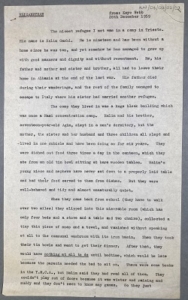 stories in seventeen days with time off for travelling and sleeping; a disturbed sleep filled with anxious eyes and quite sorrowful voices.’ She also wrote a piece for The Elizabethan, the magazine for younger readers which she had edited from 1955-58 and to which she was still a contributor. For this she focused on the story of nineteen-year old Halim Gashi (‘the nicest refugee I met’) and his family, living in a camp in Trieste. Her description highlights the emptiness of their life, with ‘nothing at all to do’ between dinner and bedtime; ‘there were some books in the YMCA, but Halim said they had read all of them’.
stories in seventeen days with time off for travelling and sleeping; a disturbed sleep filled with anxious eyes and quite sorrowful voices.’ She also wrote a piece for The Elizabethan, the magazine for younger readers which she had edited from 1955-58 and to which she was still a contributor. For this she focused on the story of nineteen-year old Halim Gashi (‘the nicest refugee I met’) and his family, living in a camp in Trieste. Her description highlights the emptiness of their life, with ‘nothing at all to do’ between dinner and bedtime; ‘there were some books in the YMCA, but Halim said they had read all of them’.
The reports drew high praise from officials at UNHCR and other refugee organisations. In February 1960 A.R. Lindt wrote to Ronald from the United Nations in Geneva: ‘my colleagues and I were deeply moved by the depth of human understanding and the sincerity of your drawings. At the same time I would like to convey to Mrs Searle my appreciation of the excellent text that accompanied the drawings. She succeeded in explaining a very complex problem in a sympathetic and lucid manner.’ Meanwhile, the British Council for Aid to Refugees also wrote to Ronald, c/o Punch, asking for information about the whereabouts of a number of the people named in the report, ahead of a Home Office Mission to the Continent ‘to select candidates for the new intake of refugees to this country’.
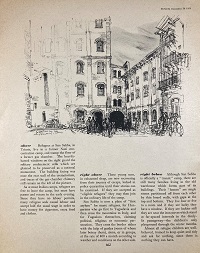 While the close focus on individual stories was key to the reports’ success, it also meant that both Searles found themselves fielding a number of well-meaning if sometimes inappropriate offers of help. The story of Wasily Mehedin, who had been totally deaf for eight years, prompted one reader in Beverly Hills to donate a hearing aid, while someone else offered to pay for a new set of teeth for Anna Barth, from Yugoslavia. In the immediate aftermath of the trip Kaye had disclosed to the editor at Life her frustrations with the slow-moving UNHCR bureaucracy, so she was happy to short-circuit the system where possible, even though it involved so much effort on her part. On 28 March she wrote to Herr Loch, one of their Austrian aid worker contacts, to enlist his help: ‘Since I got back and Ronald’s drawings have been published in Punch, there have been a great many inquiries from people who wish to help individuals. While we have tried where possible to persuade them just to offer general help, some of them are particularly keen to do something for individual families.’
While the close focus on individual stories was key to the reports’ success, it also meant that both Searles found themselves fielding a number of well-meaning if sometimes inappropriate offers of help. The story of Wasily Mehedin, who had been totally deaf for eight years, prompted one reader in Beverly Hills to donate a hearing aid, while someone else offered to pay for a new set of teeth for Anna Barth, from Yugoslavia. In the immediate aftermath of the trip Kaye had disclosed to the editor at Life her frustrations with the slow-moving UNHCR bureaucracy, so she was happy to short-circuit the system where possible, even though it involved so much effort on her part. On 28 March she wrote to Herr Loch, one of their Austrian aid worker contacts, to enlist his help: ‘Since I got back and Ronald’s drawings have been published in Punch, there have been a great many inquiries from people who wish to help individuals. While we have tried where possible to persuade them just to offer general help, some of them are particularly keen to do something for individual families.’
The final report, with all 40 of Ronald’s drawings and updated text by Kaye, was elegantly designed by Penguin’s influential typographer Hans Schmoller. Ronald was pleased – ‘I think on the whole that the reproduction is very successful’ (17 March 1960) – but he wished they had not used his ‘cartoony signature’ on the front. Hans explained that he too would have preferred a type set signature, but the cartoon style was chosen deliberately to boost sales – ‘This is the price you have to pay for fame!’ (18 March 1960).
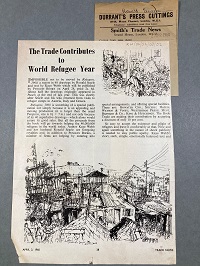 Hailed by critics, the book sold well, and within a few weeks of publication Kaye was writing to Sir Allen Lane at Penguin: ‘we are both very
Hailed by critics, the book sold well, and within a few weeks of publication Kaye was writing to Sir Allen Lane at Penguin: ‘we are both very 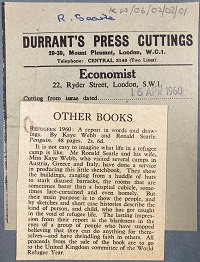 glad that this has proved so extraordinarily successful, both in the realisation of the idea from your end, and financially for World Refugee Year.’ Months later, Kaye would join Sir Allen’s team at Penguin, as she took on a new career defining challenge as ‘Outside Editor’ at Puffin Books. I can’t help wondering whether, when she founded the Puffin Club, Kaye remembered the story of Halim Gashi who had nothing to read and nothing at all to do between dinner and bedtime.
glad that this has proved so extraordinarily successful, both in the realisation of the idea from your end, and financially for World Refugee Year.’ Months later, Kaye would join Sir Allen’s team at Penguin, as she took on a new career defining challenge as ‘Outside Editor’ at Puffin Books. I can’t help wondering whether, when she founded the Puffin Club, Kaye remembered the story of Halim Gashi who had nothing to read and nothing at all to do between dinner and bedtime.
Sarah Lawrance was formerly the Collection and Exhibitions Director at Seven Stories the National Centre for Children’s Books and is now a freelance curator.
Pictures – all from the Kaye Webb archive at Seven Stories
- Refugees 1960 – a report in words and drawings by Kaye Webb and Ronald Searle, published by Penguin Books, 1960 (front cover)
- Extract from the interim report in Punch, 30 December 1959, showing Ronald Searle’s drawing of refugees at San Sabba in Trieste, with Kaye Webb’s captions.
- Typescript refugee story by Kaye Webb for The Elizabethan, 28 December 1959
- Press cutting – The Economist 16 April 1960
- Press cutting – Smith’s Trade News 2 April 1960



